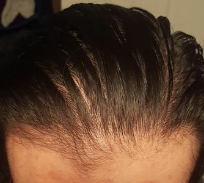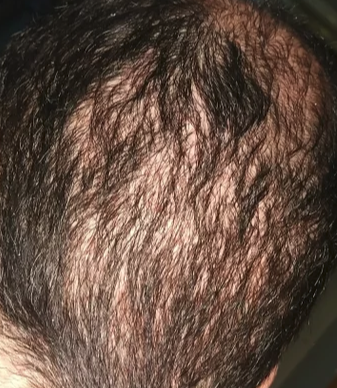If the graft was placed upside down and it grew for months, it might have grown to full length inside your scalp at a rate of about 1/2 inch per month. I am sure that your doctor remove the hair that came from the cyst (and it most likely was created from an ingrown hair).
I also have a history of having Gynecomastia when I was 15, and it was surgically removed. Will my risk be high if I start Finasteride?
Before staring the drug Finasteride, I always perform a HAIRCHECK, which accurately shows the amount of hair lost at the time the drug is started. If no hair is lost, I advise against the drug.
However, if hair is lost, then I remeasure the patient one year later to see what happened to the balding process and if the drug (1) was started, and (2) the value and the benefit, if any, of taking the drug. For young men with a history of Gynecomastia, the drug Finasteride is not any more of a risk in your situation compared to other men of your age.
A proper consultation include building a relationship between the doctor and the patient, not a salesperson. Unfortunately, too many doctors see $$$ when they see patients. I often see patients and tell them that they are not good candidates for a hair transplant or that the timing is too early. I always build a Master Plan with the patient, so the patient has both a short and long-term plan which may or many not include a hair transplant. My favorite part of what I do is meeting the patient. My practice may be unusual in that I have many celebrities and CEOs of big companies, but I also get truck drivers or students too young for hair transplants. I try to give them the materials that equips them to handle their “balding problems” and balance it with their lives.
I went to a surgeon for a consultation, and he said the following in an email to me afterwards: “Your Norwood classification is possibly Norwood 3. You may not look like this, but you are showing a similar pattern. Your Norwood classification is not meant to be seen as a progression of hair loss, but rather a genetic predisposition (like the color of your eyes).” Is this true? I thought this entire time that when you start going bald, you always end up going completely bald (at some point). This is an important question to have answered because it will determine if I end up getting transplants or not. Is it actually possible to lose hair up to, say, Norwood 3, and then the hair loss completely stops? Or is this bullshit? I’m currently 26, and the surgeon said to me that, by the time you are in your late twenties, it is relatively easy to predict what classification you fall under by just using the microscope to identify currently thinning hairs, and that most men who ended up completely bald showed clear signs of hair thinning throughout the head in their late twenties.
Yes, many people with a Class 3 pattern of hair loss will retain a Class 3 pattern of hair loss for their entire life. The original classification system was to define the end stage of hair loss patterns, not necessarily transition stages of hair loss, although some people do get transitions from a Class 3 pattern to a more advanced pattern of hair loss.
I have been taking finasteride for 10 years now, and I have been slowly losing my hair since, though at a much slower rate. I was wondering, will I eventually become slick bald in a class six pattern if that’s what my genetic fate is, even if I continue to take the medication? Does hair have to miniaturize to the point of completely not being visible anymore, or is it possible for the process to stop in an intermediate stage of miniaturization?
Look at the miniaturization pattern and try to predict your hair loss. Or, better yet, see a doctor like me with specialization in hair loss who might be able to answer your questions after a detailed examination of your scalp. Hair does not have to miniaturize for balding to occur, and most patterns can be predicted after a man is 26 years old.
Is hair thickness dependent on which phase it is in right now? The hair I shed is much different than the hair I can cut off. It is less pigmented, much thinner, and less robust. I mean MUCH thinner and not just some but all of them. Is this normal? Are hairs in telogen thinner than in the anagen phase?
When a hair miniaturizes, it becomes less thick, losing its mass. It also loses its pigment, becoming white, and it often stops growing. This hair may just hang there for a long time, not contributing to your overall hair mass.
Great story. When you start early with the approach you used (like prior to the age of 21), the likeliness of these types of results increase significantly. Many times, different hair forums focus on the worst problems that people experience and too few come forward to tell their positive stories, which I know are much more common than most people realize. Congratulations.
The drugs do work. My hair regrowth journey (with pics) from tressless
If you go back prior to the 19th century, the most common disease in the cities was tuberculosis, a wasting disease causing significant weight loss. When a person has a wasting disease, they (either man or woman) lose hair, but if there are genetic factors involved, hair loss appears earlier in men with wasting diseases. Women have estrogen which protects their hair from the effects of male hormones, which they also have in their system (just less). Howevr, women would still lose hair when they contracted tuberculosis. In these olden days, women looking for a man to marry would judge their a man’s health by the amount of hair on their head. A woman could not tell the difference between genetic hair loss (which they did not understand prior to 1900) and a sick man with tuberculosis who might die. Women would not want to marry a balding man due to fear that he would die after she might have children, then be stranded without a man to support her and her family. This prejudice continues today.
The recipient area density is never equal to the original density, nor should it be because all of the donor hair would be used up. Also, there are mechanical limits on how closely a doctor can place the grafts to allow sufficient space and blood supply for good healing
The growth is just starting. Hopefully, in the next 3 months, you will see 80% of the growth to styling length. With 1950 grafts in that area, the results should look fairly thick.
Yes, this can occur when facilities are not clean, instruments are reused with bits of human tissue in them (an example is a reusable implanter in a hair transplant commonly used by many doctors), or with sloppy techniques like a surgical technician or doctor moves between operating rooms and two different patients without adhering to the strict sterile techniques. Diseases can be transferred from one patient to another from such situations. This has been reported in the past. It puts the burden on all patients to make sure that they know the doctor, the facility, and the history behind each of these entities before making the surgical decision.
According to a Google look-up, Dr. Brotzu pioneered this lotion. It is reported to be an “Omega-6 fatty acid. It is supposed to be an anti-inflammatory lotion. It is being promoted in the product as a precursor to PGE1. Specifically, DGLA is converted to PGE1 via the cox-1 and cox-2 pathways.” There are no FDA claims that have been cleared by this. So much of what you read is hypothetical and possibly illegal in the US. I can’t say if it works or not, as I would have to read a clinical scientific paper on it first.
Page 324 of 635



